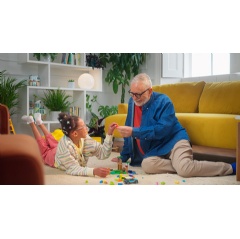The LEGO Group is urging fans to keep their bricks in play by passing them on to future generations, highlighting the enduring quality and creative potential of its iconic bricks. This message is at the heart of their new âMade to be Playedâ campaign, which celebrates the timeless appeal of LEGO sets, featuring classics like the 1978 LEGO Castle, 1979 Galaxy Explorer, and 1989 Black Seas Barracuda.
Since their introduction in 1958, LEGO bricks have been designed to withstand the test of time, thanks to their unique interlocking system and rigorous safety standards. This design ensures that LEGO bricks remain a durable and versatile toy for generations, providing endless possibilities for play and creativity. The companyâs commitment to sustainability is evident in this design philosophy, aiming to prevent LEGO bricks from becoming waste.
"LEGO bricks are designed to be played with over and over again," says Annette Stube, Chief Sustainability Officer. "We want our fans to keep them in play by passing them on when they are no longer being used."
The LEGO Group is actively exploring ways to facilitate the passing on of LEGO bricks through initiatives like the LEGO Replay take-back programme, which has been expanded to the UK after successful trials in the US and Canada. The company is also exploring trade-in pilots in the US and Germany to understand fan preferences and develop the most effective ways to encourage brick recycling.
Beyond encouraging fans to pass on their bricks, the LEGO Group is continuously pushing the boundaries of sustainable practices within its own operations. This includes increasing the use of sustainable raw materials and introducing paper-based pre-pack bags to reduce its environmental footprint. In 2023, 18% of all resin purchased was certified according to mass balance principles, signifying the company's commitment to utilising renewable sources.
The LEGO Group is also exploring innovative materials, having tested over 600 different options in the search for more sustainable bricks. Successes include bio-PE, used for botanical elements and Minifigure accessories, and arMABS, a material made from recycled artificial marble used for transparent LEGO elements. Further innovations are in the pipeline, including ePOM, a material utilising cutting-edge technology to mix renewable energy and CO2 from bio-waste, planned for use in rigid elements like wheel axels from 2025 onwards.
The âMade to be Playedâ campaign reflects the LEGO Groupâs commitment to building a sustainable future. This is evident in their increased spending on environmental initiatives â up 60% in 2023 compared to 2022, and set to double again by 2025. The company aims to reduce greenhouse gas emissions by 37% by 2032 against a 2019 baseline and achieve net-zero emissions by 2050.
These initiatives demonstrate the LEGO Groupâs dedication to creating a positive impact on the environment, ensuring that LEGO bricks can continue to inspire creativity and play for generations to come.
Article
Business

LEGO Encourages Fans to Pass on the Bricks: Building a Sustainable Future

